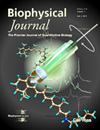动力学和脂膜耦合的RAS-RAF复合物揭示了通过多尺度模拟
IF 3.1
3区 生物学
Q2 BIOPHYSICS
引用次数: 0
摘要
为了获得RAS-RAF信号级联启动的分子和机制见解,我们开发并使用了多尺度模拟和实验方法的结合。膜对RAS和RAF蛋白的影响和影响是我们刚刚开始更详细地了解和欣赏的一个因素。分子模拟是进一步研究膜与相关蛋白之间复杂关系的理想方法。我们之前使用MuMMI(多尺度机器学习建模基础设施)研究了KRAS4b蛋白周围不同的脂质组成以及蛋白质行为与这些膜环境之间的相互作用。MuMMI使用机器学习来耦合相邻的模拟尺度,并已在世界上一些最大的高性能计算机上有效地扩展。最近,我们扩展了这个多分辨率框架,包括全原子模拟尺度,并纳入了RAF RBDCRD域。在这里,我们提出了这个新的模拟活动的总体分析结果,包括RAS和RAF RBDCRD蛋白的混合物。大约完成了35000个粗粒度和10000个全原子分子动力学模拟,从各种蛋白质/脂质组成配置中采样,这些配置是由一个微米尺度的连续模拟生成的,包含数百个蛋白质拷贝。本文章由计算机程序翻译,如有差异,请以英文原文为准。
Dynamics and lipid membrane coupling of the RAS-RAF complex revealed via multiscale simulations
To gain molecular and mechanistic insights into initiation of the RAS-RAF signaling cascade we developed and used a combination of multiscale simulation and experimental approaches. The influence and impact of the membrane on RAS and RAF proteins is a factor we are just beginning to understand and appreciate in more detail. Molecular simulation is an ideal methodology to further study this complicated relationship between the membrane and associated proteins. Our previous work using MuMMI (Multiscale Machine-learned Modeling Infrastructure) investigated different lipid compositions solely around the KRAS4b protein and the interplay between protein behavior and these membrane environments. MuMMI uses machine learning to couple adjacent simulation scales and has been efficiently scaled across some of the world’s largest high-performance computers. Recently, we have expanded this multi-resolution framework to include the all-atom simulation scale, and to incorporate the RAF RBDCRD domains. Here we present the overall analysis results from this new simulation campaign comprising a mixture of RAS and RAF RBDCRD proteins. Approximately 35,000 coarse-grained, and 10,000 all-atom molecular dynamics simulations were completed, sampled from a variety of protein/lipid composition configurations that were generated from a micron-scale continuum simulation containing hundreds of copies of the proteins.
求助全文
通过发布文献求助,成功后即可免费获取论文全文。
去求助
来源期刊

Biophysical journal
生物-生物物理
CiteScore
6.10
自引率
5.90%
发文量
3090
审稿时长
2 months
期刊介绍:
BJ publishes original articles, letters, and perspectives on important problems in modern biophysics. The papers should be written so as to be of interest to a broad community of biophysicists. BJ welcomes experimental studies that employ quantitative physical approaches for the study of biological systems, including or spanning scales from molecule to whole organism. Experimental studies of a purely descriptive or phenomenological nature, with no theoretical or mechanistic underpinning, are not appropriate for publication in BJ. Theoretical studies should offer new insights into the understanding ofexperimental results or suggest new experimentally testable hypotheses. Articles reporting significant methodological or technological advances, which have potential to open new areas of biophysical investigation, are also suitable for publication in BJ. Papers describing improvements in accuracy or speed of existing methods or extra detail within methods described previously are not suitable for BJ.
 求助内容:
求助内容: 应助结果提醒方式:
应助结果提醒方式:


